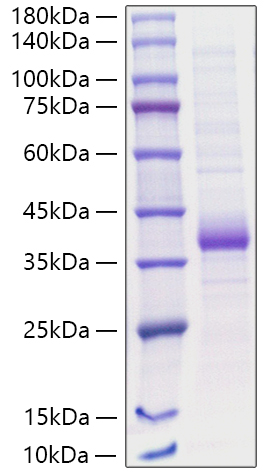Description
Recombinant Human Carbonic anhydrase 5A/CA5A Protein
The Recombinant Human Carbonic anhydrase 5A/CA5A Protein is a biologically active recombinant protein that plays a significant role in various cellular processes and signaling pathways in human biology. This protein is widely employed in immunological research, cell biology studies, protein-protein interaction analyses, and therapeutic development, providing researchers with a reliable tool for investigating Carbonic anhydrase 5A/CA5A function and its implications in health and disease.
This product (SKU: RPCB1091) is produced using HEK293 cells and features a C-His tag for convenient detection and purification. The protein exhibits a calculated molecular weight of 30.93 kDa with an observed molecular weight of 35-45 kDa under denaturing conditions, achieving ≥ 90 % as determined by SDS-PAGE.. Functional bioactivity has been validated through rigorous quality control assays, confirming its suitability for demanding research applications.
Key Features
| High Purity by Affinity Chromatography | |
| Mammalian & Bacterial Expression Systems | |
| High lot-to-lot consistency via strict QC |
| Product Name: | Recombinant Human Carbonic anhydrase 5A/CA5A Protein |
| SKU: | RPCB1091 |
| Size: | 10 μg , 20 μg , 50 μg |
| Reactivity: | Human |
| Synonyms: | CA5, CAV, CAVA, CA5AD, GS1-21A4.1, CA5A |
| Tag: | C-His |
| Expression Host: | HEK293 cells |
| Calculated MW: | 30.93 kDa |
| Observed MW: | 35-45 kDa |
| Gene ID: | 763 |
| Protein Description: | High quality, high purity and low endotoxin recombinant Recombinant Human Carbonic anhydrase 5A/CA5A Protein (RPCB1091), tested reactivity in HEK293 cells and has been validated in SDS-PAGE.100% guaranteed. |
| Endotoxin: | < 0.01 EU/μg of the protein by LAL method |
| Purity: | ≥ 90 % as determined by SDS-PAGE. |
| Formulation: | Lyophilized from a 0.22 μm filtered solution of 50mM NaAc,50mM NaCl,0.05% Brij-35,pH 5.0. |
| Bio-Activity: | Measured by its esterase activity. The specific activity is >600 pmol/min/µg, as measured under the described conditions. |
| Reconstitution: | Centrifuge the vial before opening. Reconstitute to a concentration of 0.1-0.5 mg/mL in sterile distilled water. Avoid vortex or vigorously pipetting the protein. For long term storage, it is recommended to add a carrier protein or stablizer (e.g. 0.1% BSA, 5% HSA, 10% FBS or 5% Trehalose), and aliquot the reconstituted protein solution to minimize free-thaw cycles. |
| Storage: | Store at -20℃.Store the lyophilized protein at -20℃ to -80 ℃ up to 1 year from the date of receipt. After reconstitution, the protein solution is stable at -20℃ for 3 months, at 2-8℃ for up to 1 week. |
Carbonic Anhydrase catalyzes the reversible reaction of CO2 + H2O = HCO3- + H+, which is fundamental to many processes such as respiration, renal tubular acidification and bone resorption (1). Topics in a CA meeting (6th International Conference on the CAs, June 20 - 25, 2003, Slovakia) ranged from the use of CAs as markers for tumor and hypoxia in the clinic, as a nutritional supplement in milk, and as a tool for CO2 removal and mosquito control in industry. Carbonic Anhydrase VA encoded by the CA5A gene is a mitochondrial protein (2, 3). In comparison with another mitochondrial CA (CA5B), CA5A has different tissue distribution and chromosomal location (4, 5). Expression and inhibitor studies of different CAs in the rat pancreatic beta cells indicate that CA5A may be involved in the regulation of insulin secretion (6). CA5A may also participate in the detoxification of ammonia produced in the gastrointestinal tract by providing bicarbonate to carbamyl phosphate synthetase I (7). The amino acid sequence of recombinant human CA5A (residues 40 to 305) is 79%, 77%, and 76% identical to that of canine, bovine, and rat/mouse.







